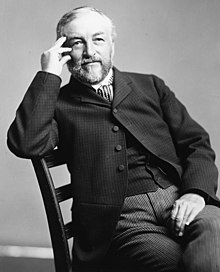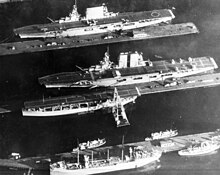A Brief History
On March 20, 1922, the USS Langley CV-1 was commissioned as the first American aircraft carrier in the US Navy. The ship had previously been a coal hauling ship (collier) named USS Jupiter AC-3 and had been converted for use with airplanes. The US Navy had seen the value of airplanes as anti-ship weapons when Army Air Corp Maj. Gen. Billy Mitchell demonstrated his ability to sink or heavily damage battleships by aerial attack. Of course, the scouting ability of an air fleet greatly expanded the ability of a sea going commander to reconnoiter the seas around his fleet in the days before radar as well.
Digging Deeper
Langley was named after Samuel P. Langley, an early aviation pioneer. Another collier was slated for conversion after the Langley, but the Washington Naval Treaty of 1922 stopped work on the battlecruisers Saratoga and Lexington and made those hulls available to be finished as aircraft carriers.

The Langley was tiny by the standards of later aircraft carriers, only 542 feet long and just over 65 feet wide. With a displacement of 13,000 tons (loaded) the ships 3 boilers powered turbo-electric engines (the first such engines to power a ship) producing 7200 shaft horsepower, enough power to drive the ship to 15.5 knots top speed and allow for a range of 4000 miles at 10 knots. She carried up to 36 aircraft and boasted 1 catapult and 1 elevator to bring planes to the flight deck. Her armament was 4 X 5 inch guns, about equivalent to a destroyer. After a couple years of testing in the Caribbean, Langley spent the next dozen years in active service, mostly in the Pacific.

In 1936, the somewhat obsolete ship was again converted, this time into a seaplane tender. When the United States entered World War II, Langley was in the Philippines, and was ordered to Australia where she served on anti-submarine patrol. On February 27, 1942, Langley was ferrying 32 P-40 fighter planes to Burma for the US Far East Air Forces when the convoy came under attack by Japanese medium bombers. Langley was hit with 5 bombs, and the Captain ordered the ship abandoned. Only 16 of the 468 men aboard were killed. She was then sunk by gunfire from US vessels to avoid allowing her to be captured by the Japanese, an ignominious end to a naval milestone.
Aircraft carriers proved to be the successor to the battleship during World War II as the capital ship of the navies of serious sea power countries. The US Navy currently operates 11 large aircraft carriers, monstrously large (1092 feet long and 256 feet wide and over 100,000 tons displacement) and nuclear powered, capable of projecting US Navy airpower to any part of the world with as many as 75 or more aircraft each. In fact, the US Navy carrier fleet is more powerful than all the rest of the aircraft carriers in service in the world today.
By comparison, the USS Langley may not seem like much, but her important place in naval history is secure, the start of a long and glorious tradition of powerful and effective US aircraft carriers. Question for students (and subscribers): If you have a particular favorite aircraft carrier or aircraft carrier story, please feel free to share it with your fellow readers in the comments section below this article.
If you liked this article and would like to receive notification of new articles, please feel welcome to subscribe to History and Headlines by liking us on Facebook and becoming one of our patrons!
Your readership is much appreciated!
Historical Evidence
For more information, please see…
Green, Michael. United States Naval Aviation 1911 – 2014. Pen and Sword, 2015.
Haskew, Michael. Aircraft Carriers: The Illustrated History of the World’s Most Important Warships. Zenith Press, 2016.
Messimer, Dwight. Pawns of War: The Loss of the USS Langley and the USS Pecos. United States Naval Institute, 1983.
The featured image in this article, a photograph of USS Langley underway, 1927, is a work of a sailor or employee of the U.S. Navy, taken or made as part of that person’s official duties. As a work of the U.S. federal government, it is in the public domain in the United States. This media is available in the holdings of the National Archives and Records Administration, cataloged under the National Archives Identifier (NAID) 520809.

